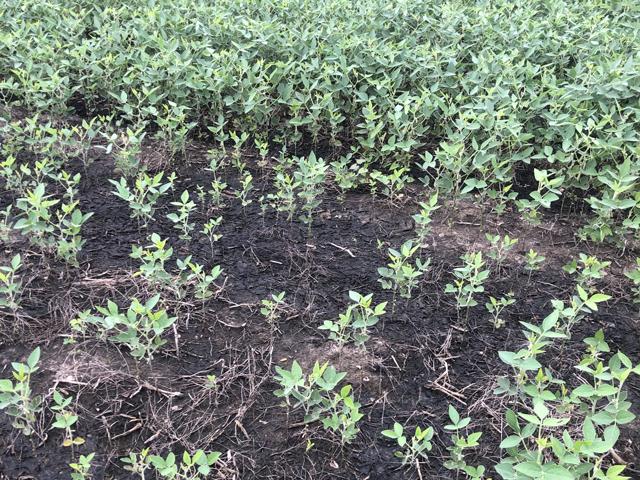Think Twice Before Replanting Soybeans
Ugly Early Soybean Stands Don't Necessarily Need Replanted
JEFFERSON CITY, Mo. (DTN) -- Early planted soybeans face many challenges but probably none greater than the prejudiced eye of a farmer. When beans don't emerge and establish with corn-like picket-fence precision, a temptation exists to replant the entire field.
While doing so might make a farmer feel better at first, it may not be the most profitable choice, said a group of agronomists and Extension specialists during a recent webinar on making soybean replanting decisions. In many cases, leaving the initial stand alone and allowing the surviving plants to compensate is the best decision for the bottom line.
"The soybean has a significant amount of phenotypic plasticity," said University of Wisconsin Extension agronomist Shawn Conley. "It's able to regrow, grow into areas and fill in gaps."
When soybeans are planted in early to mid-April, there can be a yield benefit, but the threat of colder, wet conditions and soil crusting can also slow or reduce emergence. Young plants that do emerge can be lost to late freezes or other weather events such as hail or flooding.
If such an event occurs and a grower feels replanting might be necessary, it's best to wait seven to 10 days before scouting the stand and assessing the amount and pattern of plant loss. Conley recommended using a smartphone app like Bean Cam, available for iPhone or Android, to estimate the initial plant stand. The stand can also be estimated using the hula hoop or row methods, which are described here: http://coolbean.info/….
"Having that earlier planting date and maybe not a great stand oftentimes will be more beneficial than having a later planting date and a perfect stand," said Laura Lindsey, associate professor of soybean and small grains at Ohio State University. "When you're thinking about replanting, there are several questions you need to ask. You may need to reach out to your seed dealer to see what your options are, then consider any additional costs of replanting."
P[L1] D[0x0] M[300x250] OOP[F] ADUNIT[] T[]
Replanting should be considered when stand loss leaves fewer than 50,000 to 60,000 evenly distributed plants per acre in southern regions, 75,000 plants per acre in northern regions, or when stand-loss patterns leave areas of more than 6 to 10 square feet without any plants.
Because "replanting" is essentially "delayed planting," there are few instances when starting completely over is the best course of action. Conley noted that there is a yield penalty for delayed planting in soybeans that can range from 1.4 to 2.8 bushels per acre per week.
"Unless there's some pretty significant damage, we really strongly encourage farmers to plant into an existing stand," he said. "If you've got a 35,000- to 40,000-plant stand out there, those 40,000 plants will have a higher yield potential because they were planted weeks earlier."
If soybean plant populations are above minimum thresholds but still suboptimal, there are management considerations that growers need to take into account, said Jeremy Ross, professor and soybean Extension agronomist at the University of Arkansas.
"Complete canopy closure may be delayed or never reached," he said, noting that will affect weed management. "We're really going to have to be scouting these fields. We may have to come back in with additional applications, and we're going to have to be more timely with those applications."
Without complete canopy closure, irrigation efficiency will be lower due to increased evaporation. In the mid-South, populations of corn earworm may also be higher than in fields with full canopies.
Should a grower decide to improve the stand with a repair plant, Ross said that typically, it's best to choose a variety within the same maturity group as the original planting. Herbicide trait packages and maximum in-season use rates for pre-emergent herbicides also need to be considered.
While determining what actions will be most profitable takes extra time and effort, the hardest action to accept is doing nothing.
"It goes again human psychology," said Manni Singh, assistant professor of cropping systems agronomy at Michigan State University, "but due to that phenotypic plasticity, we sometimes just need to give soybeans a little time. A lot of times, doing nothing is the best decision if we really are leaning on what is going to maximize dollars in the pocket."
Funded by the United Soybean Board through the soybean checkoff program, the Science for Success partnership brings together extension specialists from dozens of land-grant institutions across the country, representing more than 80% of U.S. soybean acres. The group recently published a national fact sheet to guide soybean replanting decisions that can be found here: https://soybeanresearchinfo.com/….
Jason Jenkins can be reached at jason.jenkins@dtn.com
Follow him on Twitter @JasonJenkinsDTN
(c) Copyright 2023 DTN, LLC. All rights reserved.






